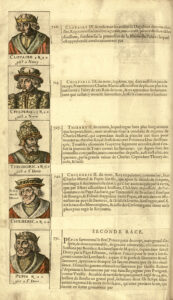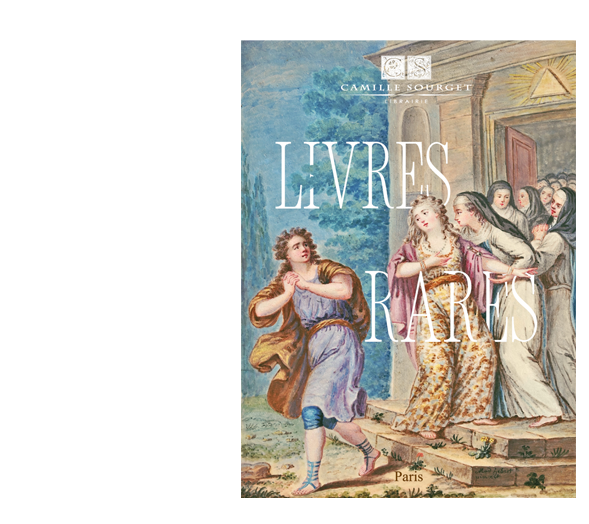Paris, chez Jean Le Clerc, 1612-1615.
Folio [343 x 209 mm] of (2) ll. including 1 handwritten frontispiece title, 1 271 pasted portraits divided into 14 suites on 250 unnumbered pages. The portraits are numbered but are in disparate order for the first suites of the book. Bound with a suite of 19 plates of portraits in black and white. A few paper repairs.
Red sheepskin from the 19th century imitating morocco, decor “à la Duseuil” on the covers, spine ribbed and decorated with gilt fleurons, some repairs.
Precious collection of 1 271 portraits sometimes called “chronologie collée” due to its special composition that varies from a copy to another. It comes in the form of a collection of historical texts and woodcuts, all printed separately and carefully pasted on wide blank leaves.
Graesse, II, 150; J. Quétif and J. Echard, Scriptores ordinis praedicatorum, II, 414; Jonghe d’Ardoye, Armorial et biographies des chanceliers et conseillers de Brabant, III, 636; Anne-Duportal, 461; Etude, p. 159; Le Blanc, II, 156, p. 275; Thieme-Becker, Allgemeines Lexikon, vol. 13, 287-288; Brunet, I, 1891.
The Chronologie collée was so called “because the figures and text are pasted in cartirdges arranged for this purpose” (Destailleur, 1891, n°438).
The process of making artificial collections with pasted texts and engravings allowed the merchants of prints to bypass the regulation and to print works that truly were books, without incurring prosecution. The most famous example of this is the Chronologie collée.
Thus, each copy presents a different content, according to the buyer’s tastes and financial means. The vignettes of this one all come from the Parisian engraver and print publisher, Jean Le Clerc and are dated between 1612 and 1615.
A title page at the beginning of the volume, copper-engraved by Gaspard Bouttats, contains a blank central medallion, completed by hand.
The collection contains 1 271 woodcut portraits, divided into 14 series each presented by an intaglio frontispiece-title: Portraitz des papes depuis S. Pierre Apostre (242 portraits preceeded by 1 portrait of the Christ), Portraitz des empereurs depuis Jules César (145 portraits), Portraits de tous les rois de France and facing Portraitz de toutes les roynes de France (93 portraits for the Queens, 56 portraits of Kings), Portraitz des empereurs d’Orient (76 portraits), Portraits des roys d’Espagne (84 portraits), Portrait de tous les roys d’Angleterre (137 portraits), Ordo et serie regum Poloniae (44 portraits), Abbrégé princes de Maurienne, comtes et ducs de Savoye (27 portraits, with that of their wives), Portraits de tous les sérénissimes ducs de Venise (90 portraits), Portraits des grands maistres de l’ordre de sainct Jean (53 portraits), Portraits des plus célèbres interprètes du droit romain (66 portraits), Les Portraits et les vies des anciens poètes latins (96 portraits), Portraits des faux dieux et déesses de l’ancien paganisme (59 portraits). Some of these portraits were made after Thomas Leu, Marc Duval, de Rabel, de Thevet, others were taken from medals or antique coins.
The copies of this book were thus made on demand and therefore present variable collations.
At the end are bound 18 large engraved plates (most cut at the margins and laminated), including a full-length portrait of the Shah of Persia and the King and Queen of Siam, published by F. Jollain; and various portraits, including Richelieu, and including 16 engraved by Nicolas de Larmessin.
Important source of global iconology, in which we find depictions of Kings and Princes, etc.
“It has been suggested that Chronologies Collees evolved under the impetus of printsellers, who, excluded from the trade in traditionally produced printed books, issued these suites of broadside engravings and letterpress to satisfy their customers’ needs. From known examples, it appears that the production and sale of series might have been cooperatively undertaken by several merchants. Though they have long been highly prized by collectors, Chronologies Collees have not received any scholarly attention whatever.
Apparently this hybrid book was French in conception and execution, though the subjects of individual series might range from the monarchs of Persia to classical Greek and Roman gods to the Kings of England. Its roots lie in the slender, highly decorative, late 16th century folios by publisher and engraver Jean Le Clerc.
These reproduced brief lives of French royalty and were enlivened with crude woodcut portraits. By the turn of the century, he had pioneered the present form, where vastly more sophisticated engravings were available with (or without) the separately printed biographical synopses. By the 1620s at least twenty such series were stocked by various printsellers, who could market individual suites, sell selected “heads” or make up a “complete” collection, to suit the demands of a particular customer.
It is also evident from surviving examples that sheets of typographic fleurons were also available, so each page of the album, with its letterpress text and engraved portraits, might be bounded by a decorative border. Thus, individual series or whole collections of Chronologies Collees could be assembled by the buyer after purchase, or they could be put together in-house by the vendor at the request of a private person.
The Chronologie Collee was, above all, a didactic tool, with which rich young French children could learn their history, genealogy and noble iconography. Simply in the course of trimming the sheets of engravings and those of printed text, determining their relative placement on the page and then pasting them in an orderly fashion into the album, a child would have mastered a tremendous amount of historical information and once the volume was completed, it could be consulted as a kind of reference book or studied at leisure.”
All the 1 271 portraits of the present copy have been contemporary hand-colored.
Copies of the Chronologies collées contemporary hand-colored are extremely rare, such luxurious copies being reserved for wealthy customers.
Precious copy of which the 1 271 portraits have been contemporary hand-colored, an exceedingly rare condition for this book rarely seen.

![[CHRONOLOGIE COLLEE]. Papes, empereurs, rois et hommes célèbres, dieux et déesses du paganisme.](https://www.camillesourget.com/wp-content/uploads/2023/03/011A_1-BD-scaled.jpg)
![[CHRONOLOGIE COLLEE]. Papes, empereurs, rois et hommes célèbres, dieux et déesses du paganisme. - Image 2](https://www.camillesourget.com/wp-content/uploads/2023/03/Reliure-cut-scaled.jpg)
![[CHRONOLOGIE COLLEE]. Papes, empereurs, rois et hommes célèbres, dieux et déesses du paganisme. - Image 3](https://www.camillesourget.com/wp-content/uploads/2023/03/Titre-BD-scaled.jpg)
![[CHRONOLOGIE COLLEE]. Papes, empereurs, rois et hommes célèbres, dieux et déesses du paganisme. - Image 4](https://www.camillesourget.com/wp-content/uploads/2023/03/Planche-5-1-BD-scaled.jpg)
![[CHRONOLOGIE COLLEE]. Papes, empereurs, rois et hommes célèbres, dieux et déesses du paganisme. - Image 5](https://www.camillesourget.com/wp-content/uploads/2023/03/Planche-2-1-BD-scaled.jpg)
![[CHRONOLOGIE COLLEE]. Papes, empereurs, rois et hommes célèbres, dieux et déesses du paganisme. - Image 6](https://www.camillesourget.com/wp-content/uploads/2023/03/Planche-4-2-BD-scaled.jpg)
![[CHRONOLOGIE COLLEE]. Papes, empereurs, rois et hommes célèbres, dieux et déesses du paganisme. - Image 7](https://www.camillesourget.com/wp-content/uploads/2023/03/Planche-3-1-scaled.jpg)
